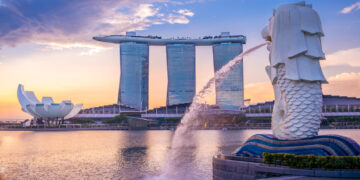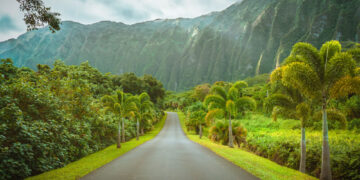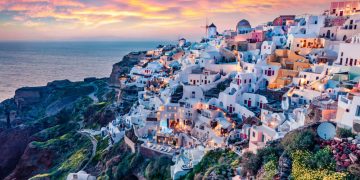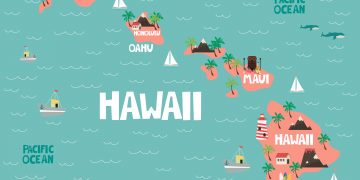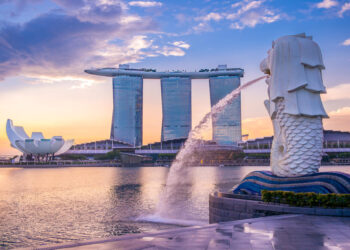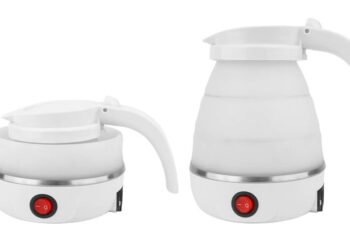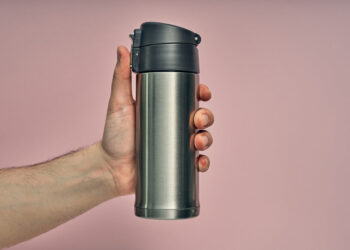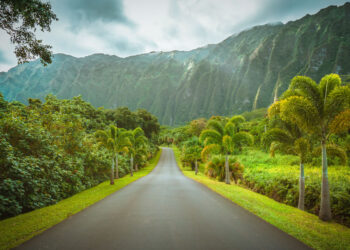Finally, there is a comprehensive Niseko Travel Guide! With the scattering of Niseko-related information on the internet, it’s our pleasure to release the Ultimate Niseko Travel Guide. This guide aims to provide all the critical information needed to plan a ski or snowboard trip to Niseko. Below you will find out when to go, where to stay, where to eat, and what to expect as part of the Niseko ski experience, hopefully clearing up gaps in your trip planning.
What and Where is Niseko?
Before we jump into the travel advice, it’s worth highlighting what and where Niseko is. Made famous for its reputation for having some of the best snow conditions in the world, most would-be visitors can hardly point out where it is on a map. Niseko United Ski Resort is located on the Northern Island of Hokkaido in Japan. More specifically, the resort is on Mount Niseko-Annupuri, in Southwestern Hokkaido, about 2-3 hours from the closest airport near Sapporo, the largest city in Hokkaido.
Why You Should Visit Niseko for Your Ski or Snowboard Trip
Niseko has become famous as a mecca for powder-seeking skiers and snowboarders over the past decades due to its incredibly deep, high-quality, and consistent snowfall totals. As the most renowned ski resort in Japan, the name has become synonymous with Japanese powder skiing.
From a geographical perspective, as ski destinations go, Niseko is privileged to be located where cold Russian winds pass over the Sea of Japan, picking up moisture and depositing it on the first mountains that the winds encounter as they hit Japan. This weather system creates a winter wonderland in the area, with snow-covered trees and constantly replenished ski trails providing the soft snow that winter sports enthusiasts crave.
Niseko’s popularity comes from a combination of factors, with the consistent snowfall attracting skiers and snowboarders for the on-mountain experience. Similarly, the weather is the main attraction for visitors from across Asia looking to experience snow for the first time in their lives or to see the beauty of constant snowfall and the landscape that comes with it.
If snowfall wasn’t enough, Niseko is a novelty to many skiers and snowboarders familiar with the North American and European mountain experiences. They dream of experiencing Japanese ski culture, including Japanese onsen (hot springs) after a day of skiing and a dinner of fresh seafood from the waters surrounding Hokkaido.
The conditions and culture of Niseko and Japan are too much to resist for those seeking their ultimate winter vacation. Fortunately, Niseko always delivers for visitors looking to live out their winter dreams.
Contents of This Guide
The Best Things to do in Niseko
Best Time to Visit Niseko in the Winter Season
How to Get to Niseko: Transportation Options
Where is the best area to stay in Niseko?
The Best Places to Stay in Niseko
The Best Places to Eat in Niseko
Ski/Snowboard Trip Essential Considerations
Budget Considerations for a Niseko Trip
Niseko Packing List Considerations
Niseko and Japan Trip Essentials
Top Reasons to Visit Niseko
Need more reasons to visit? Below are the top reasons that have attracted foreign visitors to Niseko over the years.
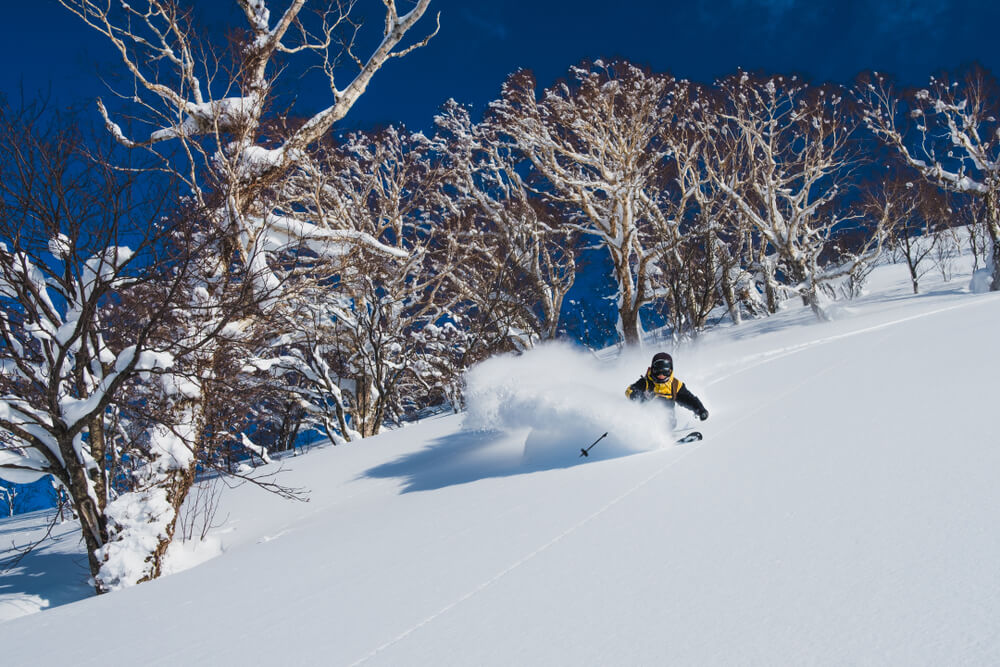
Powder Skiing and Riding: It can’t be overstated how much of an anomaly Niseko is in the ski world. Where many skiers and snowboarders dream of getting a single powder day on their annual winter trip, Niseko has plenty of weeks each season where every day is a powder day.
A Snow-Covered Dream World: Beyond just being able to slide downhill on the unlimited fresh snow, the scenery of the snow-capped mountains on Hokkaido during the winter makes for incredible scenery. Even non-skiers will enjoy the experience of just looking out the hotel windows while their travel partners are on the slopes. This point is especially true for those experiencing snow for the first time.
Japanese Cuisine: While Niseko is by no means the food capital of Japan, the off-mountain dining experience is arguably one of the best among ski destinations worldwide. The mountain hotels and villages are full of fantastic restaurants, from casual ramen shops to restaurants serving rare local ingredients and seafood that even Tokyoites travel specifically to Hokkaido to enjoy.
Japanese Hot Springs: One of the best ways to finish your day on the slopes is to feel the pleasure of taking off your ski or snowboard boots and soaking in natural geothermally heated mineral waters within minutes. It’s hard to find a better way to relax your body after a strenuous day out in the cold.
Japanese Culture: A ski or snowboard trip to Niseko typically requires foreign visitors to pass through Sapporo and Tokyo. For world travelers looking to experience more than just a ski trip during their winter vacation, a ski trip in Japan offers easy side trips that you can add to a trip itinerary.
Why You Shouldn’t Choose Niseko for Your Ski and Snowboard Trip
With the glowing recommendation written above, how could there be reasons not to visit Niseko? Yes, this seems implausible, though there are always reasons why any destination is not the perfect place for everybody. Below is a list of reasons to be aware of when deciding if Niseko is the best place for your winter vacation.
Extreme Weather: With the constant snowfall comes strong winds and limited visibility. At the same time, this winter scenery is why many visit, for skiers or snowboarders who prefer more ideal weather conditions can find themselves worn out by Niseko’s typical conditions.
Light is flat on most days, making it difficult to read the contours on the trails, and the wind can make moderately cold temperatures feel even colder. In addition, the trails are often covered with mixed snow, and while the resorts perform grooming, the effects only last for a while.
Not Enough Japanese Culture: Considering its international popularity, Niseko primarily attracts international tourists. On any given winter day, Niseko has a majority of non-Japanese citizens combined on its slopes, in its towns, and working at its ski schools, hotels, restaurants, and shops.
If you are looking for an immersive cultural experience that also happens to be your annual ski trip, there are better options at other Japanese ski resorts. This distinction doesn’t mean that Niseko is without Japanese cultural experiences, though if your main reason for your ski trip in Japan is culture, Niseko may not be the best choice.
Traveling on a Budget: There is no way around it; Niseko is not a cheap destination. Hotels are pricey, and food is, on average, more expensive than in Tokyo. However, you can find far better deals for your ski trip elsewhere between flights, bus transfers, accommodations, lift tickets, and food. If you are determined to make a trip to Niseko fit into your budget, later in this guide, we will cover money-saving tips for a trip to Niseko.
The Best Things to do in Niseko
Below are the best activities to add to your itinerary while visiting Niseko.
Powder Skiing and Snowboarding: You can’t start a list of the best things to do in Niseko without mentioning powder skiing and riding. Exceptional days at other ski resorts are the norm at Niseko, leading to its reputation as a powder snow heaven.
Soaking in a Japanese Hot Spring: More than just a way to clean yourself up and bathe at the end of a ski day. Japanese hot spring trips are a common type of vacation in Japan, and it’s not unusual for visitors to make this a core activity as part of their trip to Niseko.
Night Skiing and Snowboarding: Night skiing and riding are most commonly seen in the Western ski world at smaller ski areas, with larger resorts lighting long runs as cost restrictive. Hirafu ski area is an anomaly, with long runs lit up until the early night hours. This period is also when few are out on the slopes, making it a peaceful and relaxing time to get more runs in.
Hirafu Shopping: While Niseko is not Aspen, Park City, or St. Moritz when it comes to shopping, there are still plenty of local gifts on offer throughout the shops in Hirafu, especially local food items. If you are looking for ski or snowboard apparel to remember the trip, look for Oyuki gloves, balaclavas, jackets, hoodies, and tees in Rhythm in Hirafu.
Take in Local Art: Somoza Gallery in Hanazono offers a beautiful gallery and local art experience, with tea ceremonies in the gallery on offer as well. Shu Ogawara Art Museum in nearby Kutchan is the largest regional art museum and celebrates the artwork of local artist Shu Ogawara.
Snowshoeing or Snowmobile Tours: The larger hotels like the Hilton and Park Hyatt, along with the independent Niseko Adventure Center in Hirafu, offer off-slope winter activities such as snowshoe and snowmobile tours. These tours can book quickly during the busier months, so book ahead.
Best Time to Visit Niseko in the Winter Season
One of the most popular questions for planning a trip is when is the best time to visit? To answer this question quickly, when factoring in weather conditions, snowfall accumulation, budget considerations, and crowds, early January is generally the best time to visit Niseko. More on why that is the case down below.
Given that this is a winter guide, the below recommendations are based on the best time to visit Niseko during the winter ski and snowboard season.
The Winter Season and Snowfall in Niseko
Hokkaido’s legendary snowfall can be seen as early as late October or early November. However, the consistent snowfall that creates the base for the Niseko resorts to open generally starts in late November. As a result, the ski season begins as early as late November, most often around the first week of December, and can last as long as conditions allow, typically closing at some point during April, though as late as early May in great snow years.
Of the annual 50 feet (15m) of snow that falls on the mountain each year, the highest snowfall typically comes in the winter months of December, January, and February, with a severe dropoff in accumulations in March and trace amounts falling in early April, if at all. December and January see the most out of the high snowfall months, and late December to early January is considered the most snow-sure weeks at the resorts.
With all this said, those hoping to maximize their powder days will find the best chances for a powder day stretching from mid-December to mid-February, with fresh snowfall commonly taking place multiple days every week. It’s worth noting that there are anomalies. There can be weeks that see no fresh snowfall for a whole week, just as there can be weeks that see powder days every day.
For the best reference on current snow reports and some incredible historical reporting over the past decade, check out the Niseko Snow Report on SnowJapan https://www.snowjapan.com/japan-daily-snow-weather-reports/Niseko-Now click through the historical snowfall totals to get a sense of what a given week looks like in snowfall over the years.
Peak Times in Niseko
The primary peak season in Niseko is during the Christmas to New Years’ Holiday weeks; this time sees excellent snow conditions and crowds due to the holidays. As a result, prices spike significantly, it’s hard to find tables at restaurants, and lift lines can be noticeably longer.
Another peak time at the resorts is Chinese New Year. While this is not as busy as Christmas week, it can still see significantly more bookings and larger crowds. Several countries across the region celebrate the lunar new year, with the highest number of Chinese tourists coming at this time.
Niseko By The Month
Below is a breakdown of considerations for booking a trip to Niseko for each month of the winter season, with conditions, rates, and crowds being highlighted.
Late November in Niseko
While there are sometimes resort openings in late November, there is not a strong enough probability to recommend someone book a ski trip based on it. If you are traveling to Japan at that time for other reasons, you can check out conditions for the last-minute booking, but expect only a few trails and lifts to be open even if the resort opens.
Early December in Niseko
The Niseko resorts start to open in Early December and will slowly open lifts and trails as the snow falls. However, only some things will be open on the mountain, night skiing won’t be available, you may not be able to ski between mountain areas, and the off-piste ski areas will not be filled in with snow enough.
Prices are generally discounted for rooms and lift tickets, though off the mountain, restaurants, and shops may not yet be open or may have shortened opening hours.
There will likely be consistent snowfall, and crowds will be limited, making it great for those looking for a more peaceful vacation with plenty of snowfall.
Late December in Niseko
From mid-December, Niseko’s winter season kicks off in full. The mountain opens nearly all trails and lifts, skiing off-piste becomes possible, and restaurants and shops are fully open for the season.
Late December also sees higher prices kick in, with the Christmas week seeing the highest rates of the season. Crowds flood in for the holidays, making it Niseko’s busiest time of the season. If you have flexibility in the time you can visit, it’s better to book outside of this period, as the conditions are not necessarily better than early January, considering the rates reflect holiday visitors instead of the peak snow conditions.
Early January in Niseko
The optimal time to visit Niseko for snow conditions and the likelihood of maximizing your powder days is early January, which sees significant snowfall and typically has a deep base for going off-piste. Prices are at their peak season pricing, though they are lower than Christmas or Chinese New Year weeks.
Crowds will be at the typical mid-season levels, though they will be tolerable in terms of liftlines, with most lifts seeing short to no lines even during this period. The Hirafu Gondola is generally the only lift that will see longer lines during peak times of the day.
Late January in Niseko
Like early January, late January still sees excellent snow conditions, and the crowds remain consistently high but tolerable. Prices will generally be similar to early January, though depending on the year, Chinese New Year may be from late January to early February, making this a less-than-optimal time to visit with higher prices and crowds for that week.
Early February in Niseko
Consistent snowfall typically continues into early February, and conditions remain fantastic. There can sometimes be a dropoff in bookings at this time and slight discounts at some properties making this a great time to enjoy the conditions at a slightly better price. Chinese New Year may fall on the dates in early February, adding a peak pricing week. Crowds will still be in their mid-season form, though they will be tolerable.
Niseko Travel Guide Pro Tip: The Sapporo Snow Festival takes place in most years during the first ten days of February, making early February a great time to visit if you plan to add a couple of days in Sapporo at the beginning or end of your trip.
Late February in Niseko
In most seasons, there can be a slight drop in snow days and accumulation starting from late February. Nevertheless, the conditions are still excellent, and Niseko still sees more powder days at this time than most other global resorts. However, it is relatively fewer than earlier in the season at Niseko.
Rates will start to drop at this time, and so will crowds. Nevertheless, this remains a good time to visit on average. However, the premium to pay for the January to early February period may be worth it for those with flexibility on dates.
March in Niseko
From the start of March through the end, Niseko will see a further drop in snow days and accumulation. Temperatures will gradually warm, and icier trail conditions become more probable over the month. There is still great skiing to be found in early March, though conditions are noticeably not as good as earlier in the season.
Hotel prices will drop sharply, and there will be plenty of availability across properties. Crowds will reduce, and the season will start to appear it is coming to an end, with some shops and restaurants cutting down hours.
Niseko Travel Guide Pro Tip: Looking to pack multiple experiences into a single Japan trip? Technically the cherry blossom season starts in Mid-March on Kyushu, so it is possible to combine seeing the cherry blossoms in Japan with a Niseko ski trip, the caveat being that you will have a low probability of enjoying the legendary Japan Powder.
April in Niseko
April marks the end of the winter season in Niseko. While there can typically be more skiable days on the mountain, they will be spring skiing conditions and likely not the type of conditions you dreamed of when you dreamed of a trip to experience Japan’s legendary snowfall totals.
If you have other obligations to visit Japan at this time of the year, you can still manage to get a ski or snowboard day in, though it will likely be suboptimal snow conditions.
Prices drop further in April, with great deals to be found all over and limited crowds around. As the month progresses, you will also see more restaurant, shop, lift, and trail closures.
Best Time to Visit Niseko for Different Trip Preferences
While the snow season in Niseko may only last for a short period of time throughout the year, there are better times to visit depending on your trip preferences. Below are the best times for the specific preferences of different visitors.
Best Times to Experience Niseko Snowfall: The best times to see the legendary Niseko powder snowfall is from early December to mid-February.
Best Times for Powder Days: While December will have plenty of powder days throughout the month, the base needs to be deeper to make the entire mountain skiable. Time for a base to build makes January the ideal time for having the highest probability of powder days and a base that opens up many terrain options.
Best Times for Fewer Crowds: Crowds follow the conditions, so while early December and March are the lower seasons in terms of visitors, they also offer less-than-ideal conditions. Late February is the sweet spot where conditions are still close to ideal, though the busiest season is over and there are fewer visitors.
Best Times for Great Deals: Early December and March to April are when you will find the best accommodation deals and even discounted lift tickets.
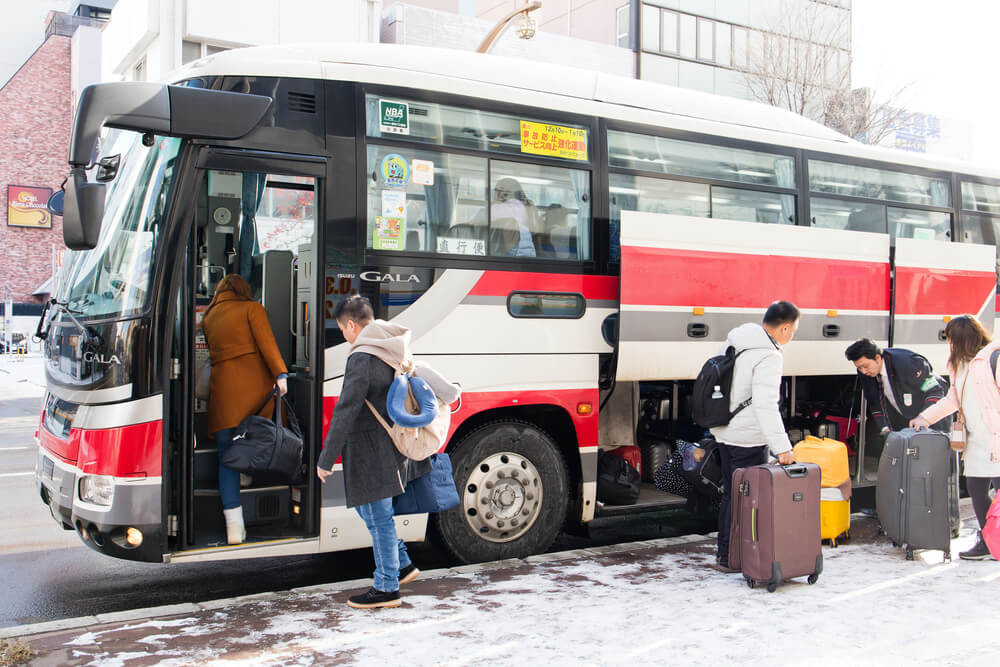
How to Get to Niseko: Transportation Options
Niseko Ski Resort is on Japan’s Northern Hokkaido Island and is around 60 miles by road from Sapporo, the nearest major city. The nearest airport is New Chitose Airport, located near Sapporo and 65 miles by road from Niseko’s Ski Resorts. Most foreign visitors travel to Niseko by flying to Sapporo and then taking a bus, train, or private transfer to the Niseko area.
While the area is technically accessible by train from Tokyo, the legendary Japanese bullet trains, known in Japan as the Shinkansen, don’t reach Niseko and require an eight-hour train journey, compared to an hour-and-a-half flight. However, the Shinkansen line is expected to extend to Kutchan Station near Niseko by 2030, reducing the journey time to around five hours.
Flying into New Chitose International Airport
New Chitose International Airport is one of the world’s best “smaller” airports and the closest airport to Niseko. While it did see 22 million annual travelers in the years leading up to the pandemic, the bulk of this is domestic business travelers. In addition, the airport has been served by direct flights from cities like Hong Kong, Seoul, Singapore, Bangkok, Beijing, Shanghai, Taipei, and Honolulu, amongst others. Many of these flights have returned to the schedule following pandemic schedule cuts or are expected to return soon.
Most travelers to Niseko will connect to one of Tokyo’s major airports, Tokyo’s Narita airport, Tokyo’s Haneda airport, or Osaka’s Kansai airport, with frequent flights to Sapporo from these destinations. At the height of pre-pandemic levels, Tokyo to Sapporo flights would be as frequent as every ten minutes during the daytime. Tokyo to Sapporo flight time is around an hour and a half, and Osaka to Sapporo is just under two hours.
New Chitose Airport is the perfect place for launching or ending your ski or snowboard trip in Japan, with a vast selection of shops selling local Hokkaido cookies, cakes, chocolates, seafood, and specialty food products. Additionally, those who are excited about the food aspect of their trip to Japan will find plenty of delicious local restaurants for seafood and sushi and a section that features branches from ten famous Hokkaido ramen restaurants.
Niseko Travel Guide Pro Tip: If your flight arrives in the late afternoon or evening and you are jet-lagged, and in need of a travel break, the Airport Terminal Hotel in the airport’s domestic terminal offers budget-friendly rooms and free access to the airport’s Japanese hot spring. Take a rest, grab some local food, enjoy a hot bath, and then move to Niseko the following day.
Stop by Sapporo
One typical itinerary plan is for visitors to Niseko to stop in Sapporo as part of their journey to or from Niseko. As a city with a population of over two million people, Sapporo offers an excellent opportunity to take in more local culture and enjoy the food, local nightlife, shopping, and the city’s attractions.
Sapporo can be reached directly in 39 minutes by express train from the Japan Rail Station under the terminal. Its compact city center is easy to navigate, and its hotels are budget-friendly. You will then be able to find the same transport connections to Niseko by rail, bus, or private car that you could find at the airport.
Traveling from New Chitose International Aiport or Sapporo City to Niseko
The transportation options from the airport and the city are similar in terms of considerations, with the distance from the airport to Sapporo being marginally longer. Visitors can choose between a bus transfer, a private transfer, or rental car, and the train. The bus transfer will be the most affordable and practical option for most, and by train will be the least practical.
Niseko Travel Guide Pro Tip: Check with your Niseko hotel or condo booking service for their advice on transfer to the area. While the below options are the most common ways to travel to the area, there are sometimes custom arrangements that different properties or services offer.
Traveling by Bus to Niseko
A few bus services offer door-to-door pickup between the airport or large Sapporo hotels and the major areas of Niseko, including some of the larger hotels. You can book tickets online ahead of time on their websites, and the bus time will generally take between 2.5 to 3 hours, depending on your destination, including a rest stop midway.
The reason that traveling by bus is the preferred option is due to: the ease of handling your luggage and ski or snowboard bags, the no-hassle direct travel process, the incredible scenery over the road’s guardrails and snowbanks from the bus, and most of all, letting a professional do the driving on Hokkaido’s treacherous snowy roads.
Book Your Bus Tickets through Hokkaido Resort Liner, Good Sports Whiteliner, or Chuo Bus. These services offer easy access to the resorts on excellent coach buses, easy booking, great customer service, and a flawless travel experience. In addition, these services have desks in the airport that you will meet at before your bus or a designated pickup or dropoff time at a list of Sapporo hotels on their websites.
Tickets range from ¥3,500 to ¥5,000 for a child to an adult one-way ticket, with some discounts on the Whiteliner for online bookings. Although Chuo Bus has slightly cheaper tickets at ¥1,500 for children and ¥3,000 for adults one way, their itineraries are typically a little longer due to more stops. So if you prefer to save a little money, Chuo is your best option.
Traveling by Private Transfer to Niseko
Private transfers can be booked through Niseko Ground Service or your hotel. A price list is listed on the Niseko Ground Service for the different options available. Generally, a bus transfer will be a more affordable option, so a private transfer is only practical for travelers who prefer more privacy and are willing to pay for it.
Traveling by Rental Car to Niseko
New Chitose Airport and Sapporo City offer plenty of rental car options for travelers to pick up a car or van before venturing to Niseko. If you are booking accommodation in Niseko that is not in the main resorts and will need a vehicle, this will be a sensible option. Additionally, if you plan on traveling out from Niseko to explore other ski resorts like Rusutsu or Kiroro, a car will make sense for your trip. Rates typically range from ¥5,000 to ¥15,000 per day for rental rates depending on the vehicle.
The main drawback of getting a rental car, which can not be overstated, is that Hokkaido roads in the winter can have highly challenging driving conditions, especially in the Niseko area. You are choosing to visit one of the snowiest places in the world in hopes of having snow-packed days on the slopes. Unfortunately, this weather means you will also need to drive in near whiteout conditions on roads consistently covered in ice or snow.
The wild card in this situation is the fact that in Japan, cars drive on the left side, the opposite of North America and most European countries. So even if you are a snow-sure driver in your home country, unless you are used to near blizzard conditions all the time on unfamiliar roads, driving on the opposite side of the road, it’s worth considering how necessary a rental car is for your vacation. This guide will cover how to get around the Niseko area without a rental car down below.
Traveling by Train to Niseko
Traveling by train to Niseko from Sapporo City and New Chitose International Airport is possible, though it is not recommended. Tickets will cost between ¥3,000 and ¥4,000 and take 2 hours from Sapporo or 2 hours and 40 minutes from New Chitose Airport to Kutchan Station. However, both of these journeys require a train change in Otaru midway into the trip, and you will still need to take a bus or taxi from Kutchan Station to your accommodation.
The additional transfer from the station will eliminate the savings over taking the bus, and there will be more hassle with luggage as the trains on these lines are not built with luggage storage, making it a more stressful journey overall. However, for those traveling light, this is a reasonable travel option if you’d like to take a stop to visit the seaside town of Otaru, famous for its seafood and old western-style buildings.
Where is the best area to stay in Niseko?
While there is no clear best place to stay in the Niseko area, there are different areas, hotels, condos, and neighborhoods better suited to different needs or preferences. Those looking for convenience to the mountain will opt for other different than those looking for the most access to dining, bars, and shopping. Below we will break down the different areas and lodging options that visitors can choose from and the essential considerations in choosing between them.
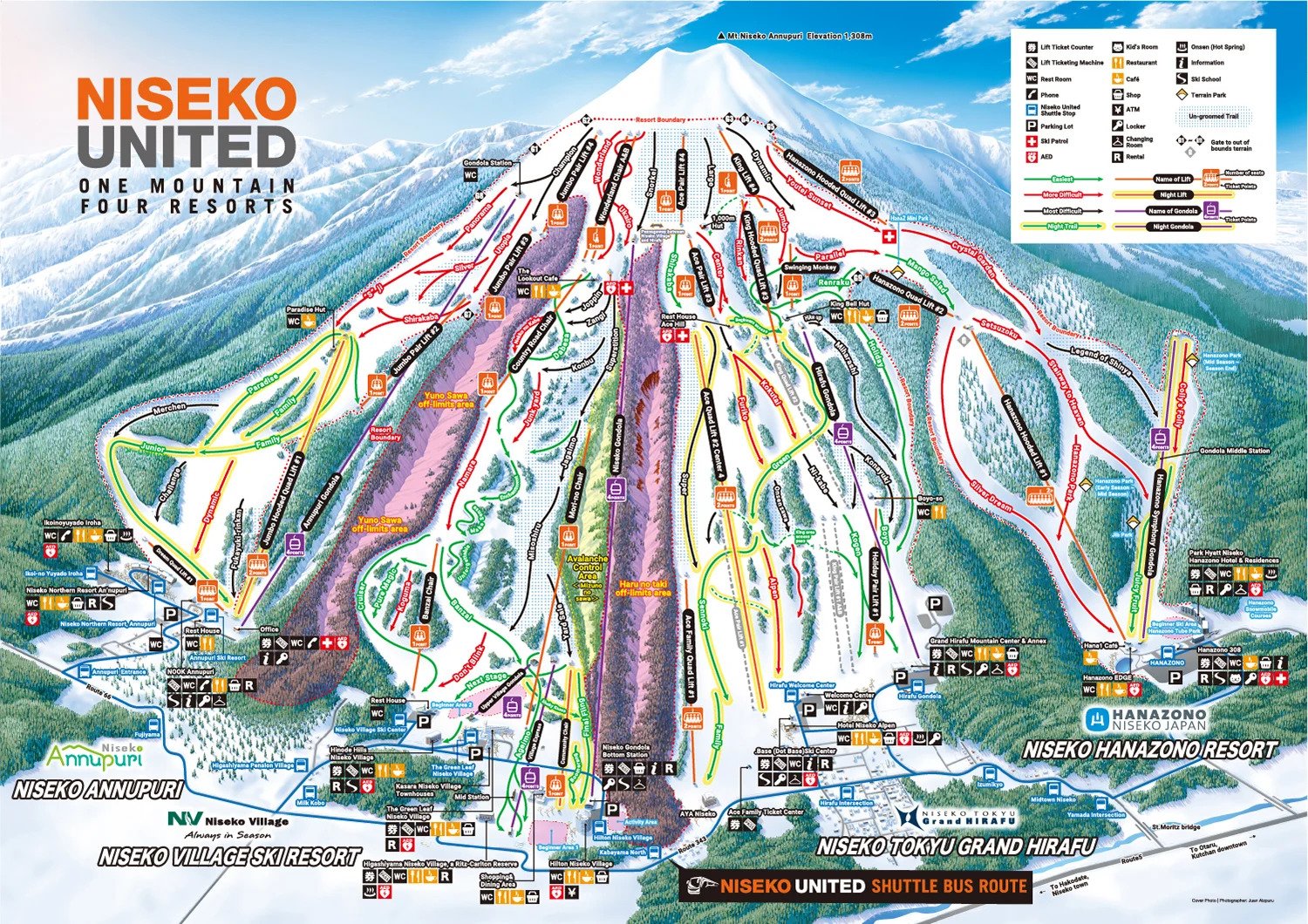
The Resort Areas of Niseko United: Get to Know the Mountain and the Area
Before considering the different decision considerations for choosing where to stay, it’s worth highlighting the different individual resorts around the broader resort area. The name ‘Niseko’ is used globally to refer to the area and, more specifically, the Niseko United resort. Niseko United is a combined four resorts situated around Mount Niseko Annupuri, the mountain on which the slopes are located.
Niseko United is a cooperative offering a joint lift ticket, which features the four resorts of the Niseko ski area. Looking from left to right along a trail map, these resorts are Annupuri Resorts, Niseko Village, Grand Hirafu, and Hanazono. The resorts are connected at the top of the mountain by trails and lifts and at the base of the resorts by a bus line managed by Niseko United and included in lift tickets.
Within these four resort areas and their respective villages, you will find the bulk of the accommodation options and dining and shopping options. In addition, various communities, small hotels, and home rentals are also located along the road that connects all four areas, which takes around 30 minutes between Annupuri and Hanazono by car.
Niseko Town is not located in the resort areas but is a separate town about 10 minutes by car from Niseko Village and Annupuri Resort. However, the town of Niseko is relatively small and is mainly ignored by winter visitors. Kutchan is a larger town located 10 minutes by car or bus from Grand Hirafu and Hanazono and is the commercial hub of the mountain area, with larger grocery stores, an electronics store, a hardware store, and more. For visitors needing to shop for their rental home or condo, more can be found in Kutchan than in any mountain village.
Which area to stay in Niseko?
The four different resort areas that makeup Niseko United each offer their own particular advantages and disadvantages and may be suited to each group based on preferences. Below is a breakdown of each area and the standout areas for those with specific interests.
Hirafu Village
Situated at the base of the Grand Hirafu Resort, Hirafu Village is the resort’s namesake and is the largest resort village around Niseko, with an enormous advantage. Hirafu is considered the main town, the dining, nightlife, and shopping center of the area, and also a walkable town (though it sits on sloped land that can see its fair share of slips and falls). The Villlage is also full of off-the-slope entertainment for the end of the ski day.
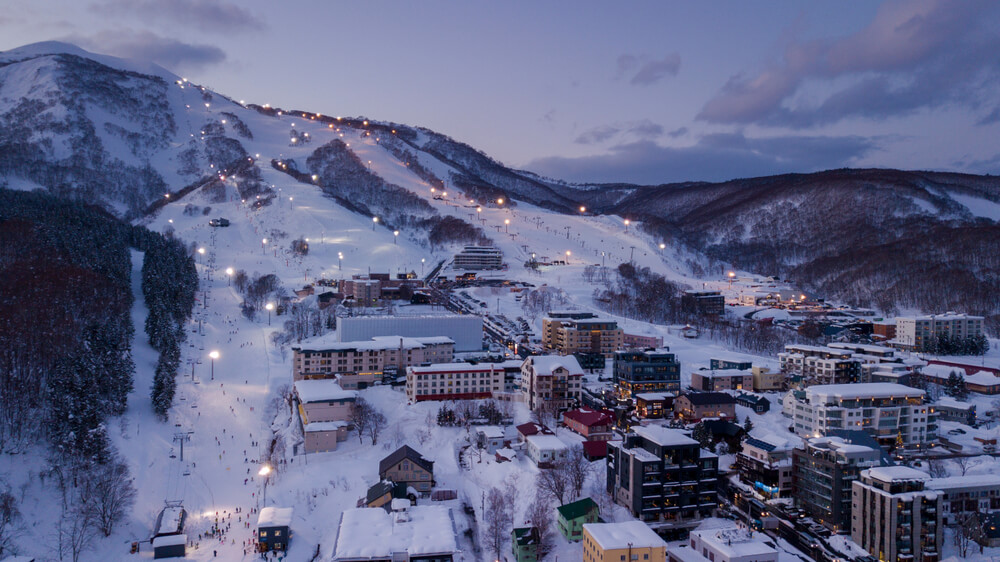
Grand Hirafu has the largest night-skiing area and is the most lively area to stay for those who want to be in the center of the action. While there are several larger hotels and condo complexes in Hirafu, most of the area comprises smaller rental houses and small condo buildings. There is a mix of some ski-in/ski-out accommodations, mainly the larger complexes, and some that require mini-shuttles or longer walks to the lifts.
Hirafu is the best option for visitors who want to be in the middle of the action and prioritize local restaurants over hotel dining. While Niseko isn’t known for its nightlife, Hirafu is the one area that has a relatively more active nightlife. Also, for those who are more budget conscious, a good deal on a condo in the Hirafu area will offer more affordable dining options as there are local convenience stores and an active food truck scene.
Its also worth noting that the village of Hirafu is separated into three areas, Upper Hirafu, Middle Hirafu, and Lower Hirafu, in reference to their location on the slope of the mountain. Upper Hirafu is mostly ski-in/ski-out or only a short, relatively flat walk to the trails/lifts. Middle Hirafu will require a short walk uphill or even a shuttle or bus ride up to the resort, and Lower Hirafu will require a shuttle ride to the resort. So make sure you know where the potential accommodation is located in Hirafu, as they are not all equal in terms of convenience.
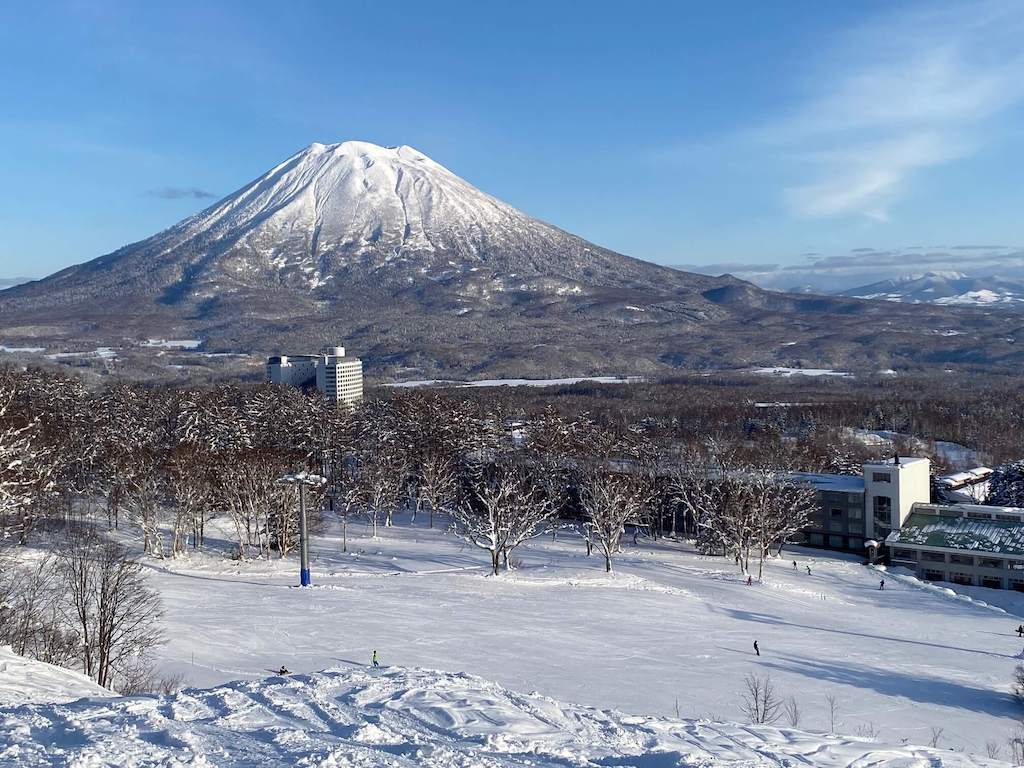
Niseko Village
The second largest area in terms of accommodation options is Niseko Village. While it could be said it is the second most “active” area in terms of off-mountain activities, most of this is based at the larger hotels in the area and their own resort offerings. The area is more spread out and is generally not walkable between the hotels and most of the area, though you can ski between some of them, and there is a shuttle.
Niseko Village’s centerpiece is the Hilton Niseko Village Hotel, with the Green Leaf Hotel, the Hinode Hills Hotel, and Higashiyama, a Ritz Carlton Hotel, also located nearby. Beyond these leading hotels, some smaller lodges and home rentals are located throughout the area.
The main hotels are all ski-in/ski-out, with some of the most convenient infrastructure for skiers in the area, with lifts and gondolas making it easy to move between. The hotels offer several restaurant options, which tend to have higher-end prices, though they all offer a shared shuttle that goes between the area to Hirafu for those planning on dining out or shopping in the evenings.
Staying in the Niseko Village hotels is one of the best choices for those who want a laid-back environment, easy access to the slopes, full resort amenities, and some of the best hotel hot springs in the area. The primary downside is that you are not in the center of the action like Hirafu, though this characteristic is also shared by Annupuri and Hanazono areas.
Annupuri
Taking up the Southern end of the resort, or the left side of the trail map, Annupuri is a quieter neighborhood-like village that features a handful of hotels, including some larger properties. As a result, the area lacks the corporate resort vibe that Niseko Village’s integrated resort area offers and is significantly quieter than Hirafu.
The ski area offers excellent intermediate and beginner terrain. At the top of the lifts, there is easy access to several of Niseko United’s sidecountry gates for the avid skier looking to go out of bounds. The area sees less skier traffic and is next to the small neighboring Niseko Moiwa resort, an independently run small mountain next to Annupuri.
Annupuri has a scattering of restaurants, though many of its hotels typically will include meals. The hotel experience in the area is distinctly more Japanese than the other Niseko ski areas, with many of the hotels being of older age, offering more budget-friendly prices, and a charm that can be found at hotels across Japan, though it is often missing in Niseko. Niseko Northern Resort Annupuri provides ski-in/ski-out access, while Niseko Grand Hotel Hokkaido and Hotel Kanronomori both run their own free ski shuttles to the ski areas.
Hanazono
The smallest ski area with the newest lifts, Hanazono has seen a makeover in the last few years, with the Park Hyatt Hanazono opening pre-pandemic and lift upgrades happening over the past three years, including a new gondola. As a result, Hanazono does not come with a village vibe like Hirafu, or a widely integrated resort vibe like Niseko Village, or even a neighborhood vibe like Annupuri; it is primarily a stand-alone hotel, with the Park Hyatt front and center. More planned resorts will open in the future, though these will all be scattered in the area.
Hanazono offers a great variety of terrain, with a newly expanded beginners’ area, with a gondola to allow learning without ski lifts. In addition, it has suitable intermediate terrain and a terrain park. As you reach the higher parts of the mountain, the advanced and expert terrain shines and is quite famous for its resort boundary gates giving even more access to sidecountry terrain.
The Hanazono area has a scattering of small hotels and home rentals, with more to be built soon. However, the main attraction in terms of lodging is the Park Hyatt, which is the most luxurious hotel offering in the area and includes plenty of in-hotel dining options to keep guests satisfied off the slopes.
Other Resort Areas
While the above four mountain areas feature the bulk of the area accommodations, there are still plenty of home rentals and small lodges or hotels on the roads connecting to these areas. In addition, neighborhoods such as St. Moritz or Kabayama are only a few minutes by bus, car, or shuttle to the Hirafu ski lifts. These other areas offer more expansive home offerings and are great for groups with their own transportation.
Best Area for Dining and Nightlife: Hirafu is the clear winner with its variety of restaurants and the only real bar scene in the area. Food options range from cheap convenience store and food truck options to local izakaya and more expensive Japanese seafood restaurants with grilled fish and sashimi offering the best of Hokkaido’s offerings.
Best Area for a Resort-style Ski Experience: Niseko Village offers the most options for most budgets, with the massive Hilton Niseko offering dining, activities, and lifts and trails right outside the hotel doors, though Hanazono is starting to make a claim for this title in recent years with the opening of the Park Hyatt, one of Niseko’s top properties at the moment.
Best Area for Begginger Skiing and Snowboarding: Niseko Village’s beginner area is the best choice for brand new skiers and snowboarders with a great beginner area and gondola cabins to avoid the need to get on a lift on their first day. Hirafu is a good option for beginners who have the basics down but need repetition on gently sloping trails.
Best Area for Intermediate Skiing and Snowboarding: There isn’t a clear winner regarding intermediate skiing and snowboarding terrain, as the mountain has a fair amount distributed across each area. Intermediates will have solid run choices in each area and can easily move between areas over the top.
Best Area for Advanced/Expert Skiing and Snowboarding: While all ski areas are set on the same mountain, Hirafu would be the best choice due to its central location to the neighboring areas and its lifts, making for the easiest way to reach the terrain at the peak. Niseko is known for its back and sidecountry skiing off Annupuri and Hanazono, and from Hirafu, you can easily reach either side of the resort.
What to Consider Before You Book
Like any ski trip, booking a hotel in Niseko offers more considerations than just getting a bed for the night. Below are a few questions to ask yourself when you are deciding on where you want to stay in Niseko.
How will you get around? – We will cover the transportation options in the area below, though it’s worth making this your first consideration. Some fantastic home rentals in the Niseko region are great bargains for larger families or groups. The downside is you need your own transportation. If you are going without a vehicle rental and not staying in the main ski areas, check what transportation the property or booking service will offer you.
Is ski-in/ski-out worth it for you? Always priced at a premium to other ski resort lodging, it’s worth considering how much you want to pay not to carry boots, skis, poles, helmets, and more when walking, bussing, or shuttling to the ski lifts.
What will you eat, and where will you eat? You found a great deal on a small lodge in Annupuri that beats everywhere else on price. While the bargain may seem difficult to pass up, you must consider where you will eat. The lodge may have a package that includes Japanese breakfast and dinner sets, though if you or someone in your group are picky eaters, this could limit meal choices.
Do you want a kitchen to cook your own meals? Condos and home rentals with kitchens are widely available in the area. While some visit Niseko to enjoy the dining scene, kitchens can provide budget-conscious families with small children with a more accessible and affordable way to eat meals. Even if you plan on eating some meals out, if your focus is on having long days of powder skiing, being able to unwind with drinks and food at your place is a great way to relax at the end of a tiring day.
Are you looking for a property with a hot spring? An essential part of the Niseko ski experience and a top recommendation from this Niseko Travel Guide is ending your day in a Japanese onsen, with the hot spring water soothing your muscles. Many hotels and condo complexes in the region have public onsens, and some even offer private onsen rooms with small baths for those who prefer not to get naked with others in public baths. However, private onsens can often come with a steep price, so think about how essential that is to your trip budget and experience.
What extras do you want on your vacation? Resorts and hotels offer many additional amenities in the area, from local cultural experiences to recreation like snowmobile and snowshoe tours. Beyond these activities that have additional costs, hotels offer a range of ski lockers to ski valets, who will take your skis, boots, poles, and board and put them in a drying room for you. Every level of service is available in Niseko at every price level.
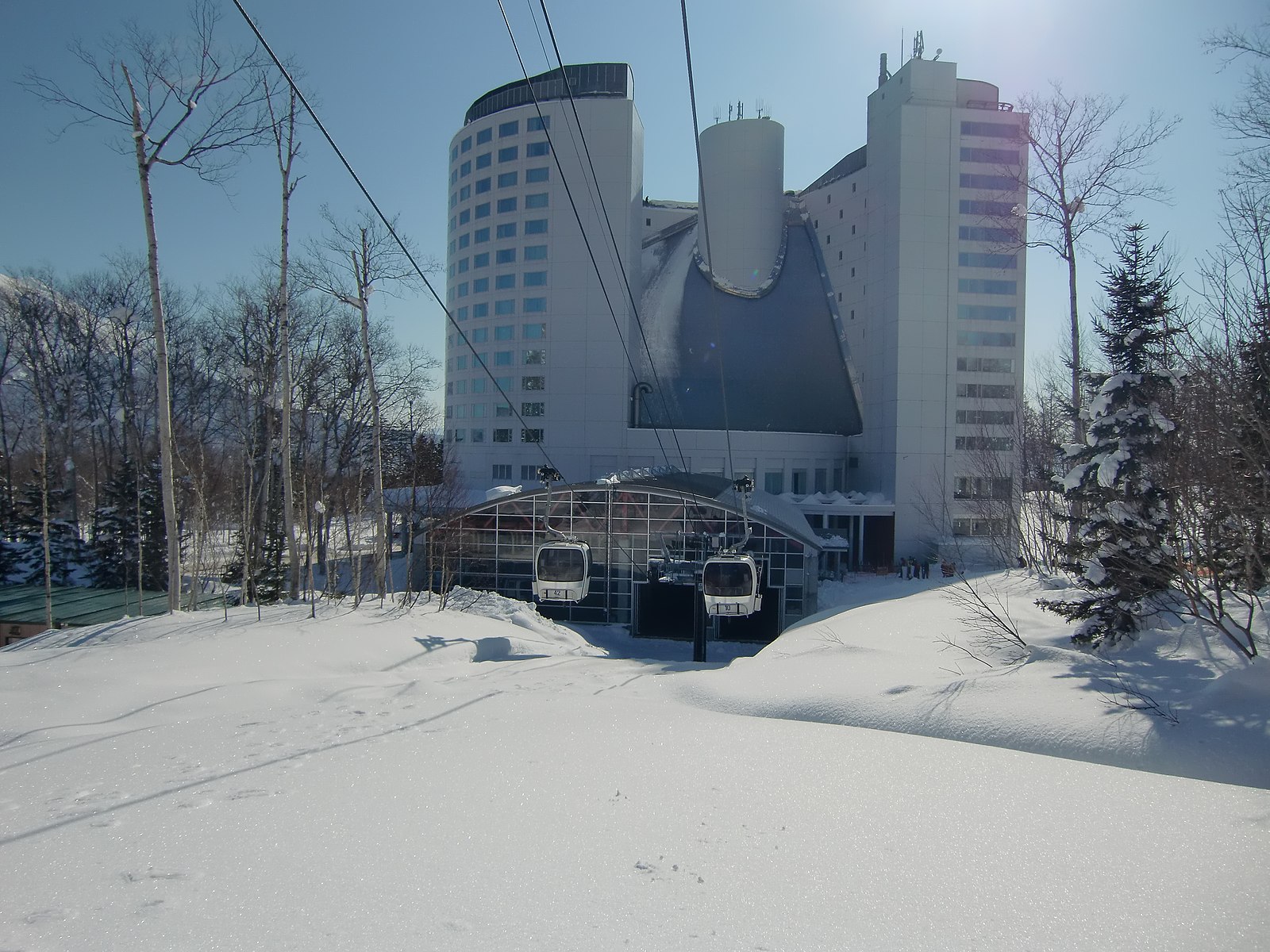
The Best Places to Stay in Niseko
Now we have made it to the list of recommended properties. Below is a list of the top picks for accommodation in the Niseko area. These are primarily hotels and condo complexes, which offer the most rooms. However, there are plenty of great home rentals, and there will be a list of booking services where you can find these below.
These accommodation options are listed in no specific order and range across the various resort areas. There are constantly new openings of properties and lodges in the area, so this list is not exhaustive, though if you are looking to choose reliable options with good reputations, the below will make your decision process more manageable.
Hotel Rate Guide
Niseko hotels are expensive. Even the so-called budget-friendly options are priced higher than most global ski destinations’ budget options, the price ranges below are only an indication, and high or low demand can create exceptional rates across the hotels listed below.
High-end Accommodations: ¥50,000 and up per night
Mid-range Accommodations: ¥20,000 to ¥50,000 per night
Budget-friendly Accommodations: ¥5,000 ¥20,000 per night
Top Picks High-end Accommodations
Park Hyatt Hanazono
Starting with the most luxurious and one of the newest large properties in the area, the Park Hyatt Hanazono sits right in front of Hanazono’s lifts and offers arguably the top hotel experience in the area at the moment.
The Vale Niseko
This luxury apartment hotel offers one, two, and three-bedroom apartments and sits at a ski-in/ski-out in Hirafu. Walking distance to everything Hirafu offers, it is perfect for those who want easy access to skiing, dining, and shopping.
Aya Niseko
Located directly next to The Vale, the Aya is a slightly more recent opening. Similarly, it features studio to three-bedroom apartments that are all luxuriously appointed and as convenient as its neighbor to a lift next door.
Higashiyama Niseko Village, a Ritz Carlton Reserve
The Ritz Carlton Reserve name says it all. This small luxury hotel in Niseko Village offers well-appointed rooms in a more secluded location. Still, ski-in/ski-out tucked away from Niseko’s busier areas, is an excellent spot for those who prefer a more private hotel experience.
Skye Niseko
Located in the middle of the slopes of Hirafu, as far as you can go up in the village, Skye is a luxury condo hotel with studio to four-bedroom options. It sits on land next to the slope and is about as well situated for your ski day as you can find. The only downside is that it is pretty far uphill in Hirafu, so it does require a ten-minute walk downhill to reach most restaurants and shops.
Ki Niseko
Similar to Skye and situated close nearby off the slopes at the top of Hirafu Village, Ki offers hotel rooms to two-bedroom condos and sits right next to the Hirafu gondola, making it one of the most ski accessible hotels in Hirafu.
Setsu Niseko
Located at the bottom of the Upper Hirafu area, Setsu Niseko is a new luxury hotel that has hotel rooms to four-bedroom suites. However, it does not offer the most effortless walk to ski trails or lifts, so it runs a shuttle continuously throughout the day for a few-minute ride to the Hirafu Gondola.
Sansui Niseko
Located towards the top of Upper Hirafu with ski-in/ski-out access, Sansui offers hotel rooms to three-bedroom suites and features the modern Japanese decor that has become a fixture of the Niseko area.
Top Picks Mid-range Accommodations
Hinode Hills Niseko Village
One of the newer properties in Niseko Village, Hinode Hills, is a small hotel with luxury decor and design, offering easy access to the slopes and a full-service ski hotel experience. The property offers hotel rooms to three-bedroom suites.
Hilton Niseko Village Hotel
The largest hotel in the Niseko area, the Hilton has been the premier full-service resort experience in Niseko over the past decades. The Niseko Village gondola sits only steps outside the hotel, and with a ski shuttle and several restaurants, the Hilton has everything you need for a relaxing ski vacation.
Chatrium Niseko
Centrally located in the middle of Hirafu, Chatrium Niseko offers studio to three-bedroom suites in a modern and well-appointed hotel. Priced slightly below the newer and more luxurious options, Chatrium is an excellent value for those looking for something fresher but easier on their budget.
Green Leaf Hotel
This slope-front hotel is excellent for those who want the ultimate ski-in/ski-out accommodation. Part of the Niseko Village shuttle bus route, the Green Leaf also provides ski lockers and both indoor and outdoor onsen.
Hotel Alpen
Older Hirafu hotel that sits right at the base of the ski area. Though it’s one of the older hotels, it still has charm and comes with an onsen and the Niseko ski vacation essentials like ski lockers.
Niseko Northern Resort Annupuri
Annupuri’s largest full-service hotel sits slopeside and is the best choice for those staying in the area. It features ski lockers and an onsen as well. This property is the top Annupuri pick according to this Niseko Travel Guide.
One Niseko Resort Towers
One of the larger hotels sits just outside the Annupuri area village. As a full-service hotel, One Niseko Resort Towers provides its own full-size bus to shuttle guests between the ski areas.
Chalet Ivy
Located midway up Upper Hirafu, Chalet Ivy is a small, conveniently located hotel that offers easy walking access to both Hirafu Village and the ski area.
Yumoto Niseko Prince Hotel Hirafu
One of Hirafu’s oldest hotels still delivers an excellent ski experience. Its convenient location makes it walkable to Hirafu, and its delightful onsen makes for a perfect end to a ski day.
Niseko Grand Hotel Hokkaido
One of the area’s oldest hotels, Niseko Grand Hotel Hokkaido, is best known for its large indoor and outdoor onsen and traditional Japanese rooms.
Hotel Kanronomori
Another classic area hotel, Hotel Kanronomori, is in the Annupuri area and offers traditional Japanese rooms, large onsen, and some more affordable private rooms in Niseko.
Top Picks Budget-friendly Accommodations
Midtown Niseko
One of Niseko’s larger budget-friendly hotels, Midtown Niseko is new and features modern decor in its great-value small rooms. Rooms are available with up to three beds, making for a good option for groups on a budget looking for private bathrooms with their rooms.
Black Diamond Lodge
A lodge made for skiers and boarders, Black Diamond sits in Higashiyama near Niseko Village and is a ten-minute walk to the lifts. With a hostel-like environment and both private and shared rooms available, Black Diamond offers some of the best rates in the area.
Torifito Hotel and Pod
Located in Kutchan, this budget hotel offers small pod-like rooms, some even with four beds. Opened just before the pandemic, the hotel is clean and modern and offers highly affordable prices. Bathrooms are shared, and the hotel is in Kutchan, which requires a bus to the ski area.
MY Ecolodge Hostel
On the outskirts of the Hirafu area, MY Ecolodge Hostel offers private rooms and dorm options, with multi-bunkbed rooms bookable to larger groups. Newly built and with no frills, the lodge is one of the best values in the area.
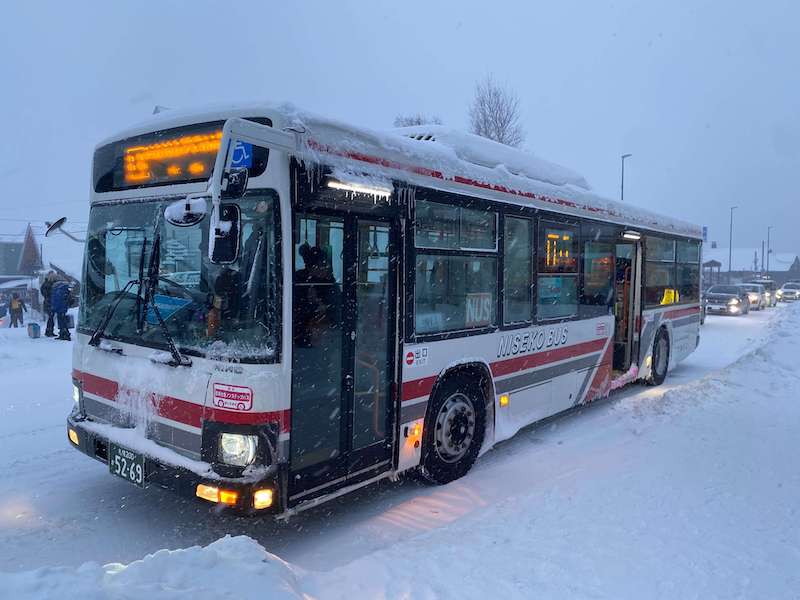
The Niseko Travel Guide: How to Get Around Niseko
One of the trickier parts of a trip to Niseko is getting around the area once you arrive. However, for most visitors staying at one of the larger hotels in the Hirafu area, or in a well-managed complex or the home rental that offers pickup/dropoff services, it’s easy enough to get around using the different local buses and shuttles.
A car rental may be essential for your trip if you are outside walking distance of the resort areas and not included on bus or shuttle routes. Ask how to get around before you book a home rental. The rental agency will be able to explain the transport options for each property they manage.
Getting Around by Car Rental
As mentioned above, before you book a car rental, make sure you are up to the challenge of driving in the constant snow and wind that reduces visibility and covers roads. If you are confident enough to book a car rental, you’ll find that from a navigation perspective, the area is made up of few roads, making it difficult to get lost, and there is also plenty of parking, all of which is free by the ski resort bases.
For picking up your rental car, it makes the most sense to pick one up from New Chitose Airport or Sapporo. While the Niseko area has car rental agencies, you’ll find better rates and more vehicle options and save money from booking transportation to Niseko by bus or train.
Getting Around by Bus and Shuttle
Most visitors to Niseko leave the winter driving to others, which is a good way of cutting unnecessary stress from your trip. The first place to check for transportation options is your hotel’s website, concierge, or rental agency, as many properties run their own shuttles around the area, some on schedules, some on demand.
Beyond shuttles, there are several bus options around the Niseko area, each with its own schedule and different stops. Below is a list of the available shuttles, with a full list of schedules shown here.
Niseko United Shuttle Bus: The bus service operated by the ski areas. It connects the four ski areas and is included with Niseko United lift tickets (note it is not included with lift tickets only for individual areas). Individual tickets can be paid for on the bus with exact change. If you have a Niseko United all mountain pass valid for the day you are riding the bus, you will need to let the driver scan it as you exit the bus.
Hirafu Village Shuttle: This small shuttle stops throughout the Hirafu area and some nearby neighborhoods.
Niseko Village Shuttle: Connecting the Niseko Village hotels with Hirafu and Kutchan Station, the free Niseko Village Shuttle is available to guests staying at the Niseko Village hotels.
Hanazono Shuttle: The free shuttle bus run by the Hanazono resort connects Hanazono resort with Hirafu Village’s upper area.
Local Bus Lines: The Donan Bus, Niseko Bus, and Night Go Bus connect the ski areas with local towns. This service includes Kutchan and its train station.
Note that the Niseko United and Local Bus Lines allow for tickets to be paid for in cash and coins on the bus. So take a ticket as you board the bus, and pay the corresponding amount that shows on the fare table in the front of the bus when you get off.
Getting Around by Taxi
Unfortunately, Niseko doesn’t have the same ride-hailing app coverage as other parts of Japan and the world. Pre-ordered taxis are still the way to get around without a bus, shuttle, or rental car. Hotels can help book taxis. If you are taking one for dinner, they can also schedule a return trip for you. As a point of reference, a taxi from Hirafu to Kutchan will run about ¥2,500.
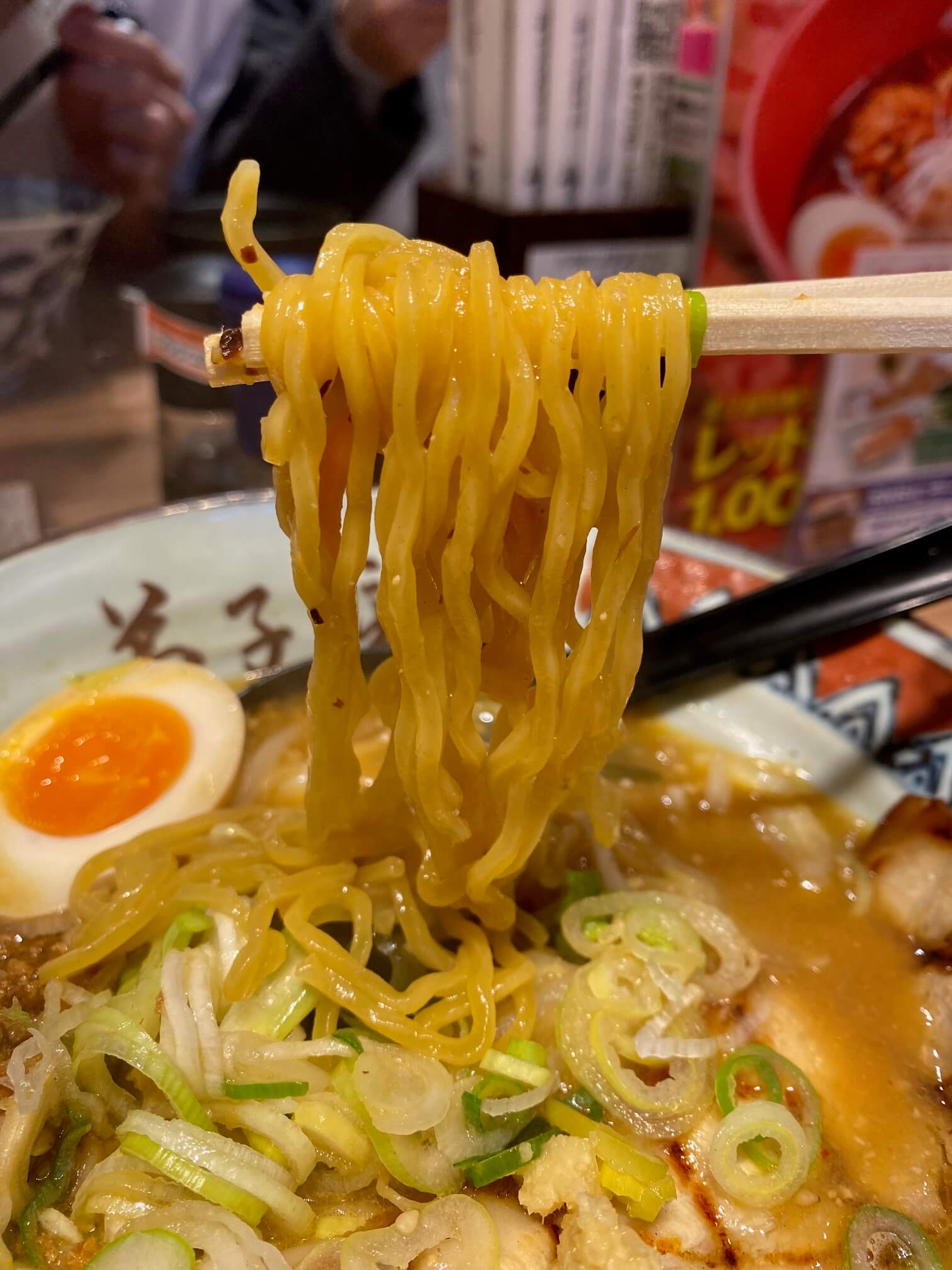
Best Places to Eat in Niseko
The Niseko dining scene is undeniably diverse and expensive. However, with primarily foreign tourists visiting the area, there are restaurants to suit all tastes. Some offer traditional Japanese and Hokkaido cuisine, and others provide creative fusion menus, making the most of local ingredients and western techniques.
It can be a challenge to eat on a budget in Niseko. Convenience stores or food trucks are necessary for many skiers and snowboarders trying to save money on their vacations.
Below is a list of recommended restaurants in the area. The list comprises Hirafu-based restaurants primarily and excludes the Hilton and Park Hyatt restaurants. The Hilton and the Park Hyatt have several fine restaurants for a nice ski lunch or dinner if you are staying in Niseko Village or Hanazono. However, for anyone staying in Hirafu, or those venturing out for dinner, the hotel restaurants are not worth a diversion from the independently owned restaurants in the area.
From a price perspective, the below list is split into three price ranges: high-end, mid-range, and budget-friendly. However, it is worth noting that mid-range restaurants often have expensive seafood dishes like sashimi or grilled fish that could make your bill more comparable to a high-end restaurant.
Niseko Travel Guide Pro Tip: If you want to eat at a restaurant, book reservations ahead, far ahead. Book as early as possible, even as soon as you make your flight or hotel bookings. Some restaurants book out way ahead of time, and there seems to be a shortage of table availability at many restaurants throughout the season. Sometimes, you may need to make a credit card deposit for a booking, though there is typically a reasonable fare cancellation policy.
Cost of Meals in Niseko
High-end Restaurants: ¥10,000 and up per person
Mid-range Restaurants: ¥2,000 to ¥10,000 per person
Budget-friendly Restaurants: ¥2,000 and under per person
Niseko Travel Guide Top Picks High-end Restaurants
Kamimura Niseko (Hirafu): Niseko’s top fine dining restaurant offers French Japanese fusion out of Ki Niseko.
The Barn by Odin (Hirafu): Iconic contemporary loft building in Hirafu offers upscale Japanese-Western fusion made with local ingredients.
Rakuichi (Annupuri): Handmade soba made right in front of diners and served as part of a set menu of Japanese specialties. This is the top choice of this Niseko Travel Guide. Though very difficult to book, make sure to book online.
Niseko Travel Guide Top Picks Mid-range Restaurants
Bang Bang and Bang2 (Hirafu): Two restaurants that are longtime Niseko institutions, right next to each other. Serving yakitori and local Hokkaido grilled seafood.
Abucha 2 (Hirafu): Seafood-focused izakaya centrally located in Hirafu, specializing in local Hokkaido dishes.
Izakaya Kougetsu (Hirafu): Cozy izakaya with a seafood-focused menu that includes grilled fish, squid, and fresh raw oysters.
La Villa Lupicia (Kabayama, near Hirafu): Large restaurant serving French and Italian fare focused on using fresh local Hokkaido ingredients.
Ezo Seafood (Hirafu): One of Hirafu’s best sushi restaurants that serves only takeaway platters, serving sushi favorites and local Hokkaido specialties.
Steak Rosso Rosso (Hirafu): Western-style casual steak restaurant serving Japanese beef.
Fuji Sushi Niseko (Hirafu): Typical Japanese sushi restaurant that serves all of the popular favorites.
Niseko Sakura (Hirafu): Shabu Shabu restaurant that is best hot pot restaurant in Hirafu.
Milk Kobo (Higashiyama, near Niseko Village): Cafe at a local dairy farm that serves casual fare made with Hokkaido dairy products. Famous for their ice cream.
Izakaya Raku (Hirafu): Hokkaido-style izakaya that specializes in grilled fish and seafood.
Niseko Travel Guide Top Picks Budget-friendly Restaurants
Tozanken Ramen (Hirafu): Longtime Niseko ramen restaurant serving a style of ramen from Asahikawa, a larger city in Central Hokkaido.
Green Farm Cafe (Hirafu): Casual cafe that serves the best brunch in Niseko.
Afuri Ramen (Hirafu): Branch from a Tokyo-based ramen chain that specializes in Yuzu flavored ramen broth.
Taj Express (Hirafu): This Indian food truck that has a long history in Hirafu is famous for its easy-to-eat wraps.
Elvis Kebab (Hirafu): Another longtime Hirafu food stand that serves kebabs.
Niseko Travel Guide Recommended Bars
Niseko’s nightlife scene may seem tame compared to some rowdier ski towns and villages in North America and Europe. However, with near-daily powder days, there is rarely an off day, so most avid skiers and boarders call it an early night to be up for first tracks. There are a few good bar options for those looking for some apres-ski beverages.
Bar Gyu (Hirafu): Niseko’s oldest and most iconic bar is famous for its refrigerator door entrance, offering cocktails in an intimate and memorable environment.
Toshiro’s Bar (Hirafu): Tokyo-style whisky and cocktail bar serving elevated drinks.
Wild Bill’s (Hirafu): A typical ski town bar that gets as wild as you find in Niseko. Serves western-style bar food as well.
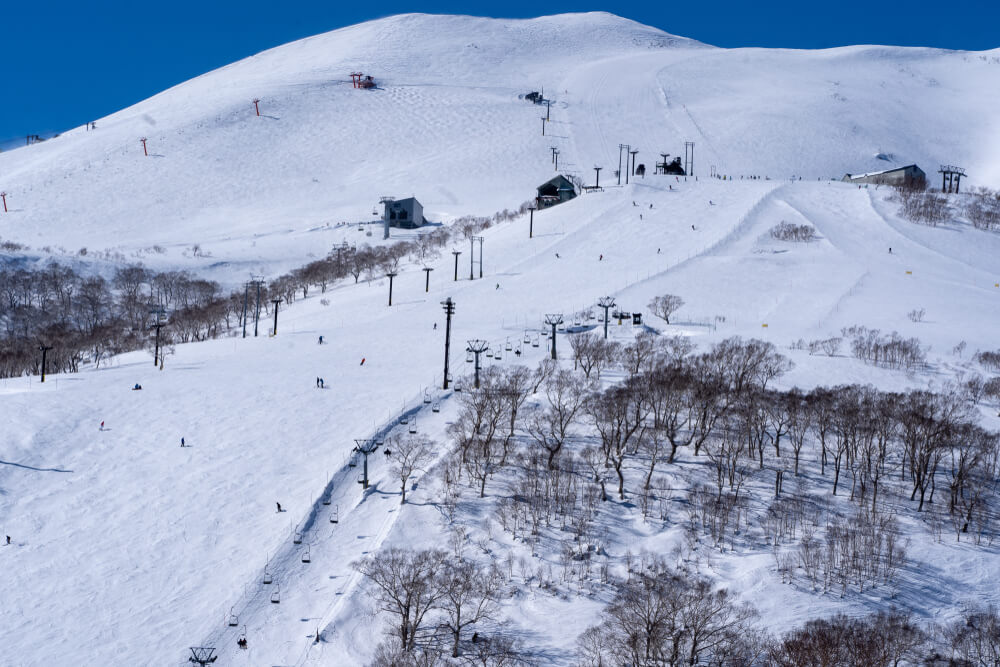
Niseko Travel Guide: Guide to the Mountain
As covered above, Niseko United is the all-mountain resort name for a cooperative of the four resorts that sit on Mount Niseko Annupuri. Therefore, you can buy an all-mountain lift pass for all four resorts or a pass for an individual resort. The resorts are connected at the top of the mountain, with trails and lifts linking the resort areas. On days when there are lift closures due to wind, you will need to take the Niseko United Shuttle Bus between areas, which is included as part of the all-mountain pass.
Weather Conditions in Niseko
Niseko is a unique wonder of the ski world, with powder days being the norm during the peak season at Niseko and clear skies being rare exceptions. Check the Snow Japan daily snow reports to track conditions, with measurements of accumulation daily of the previous 24-hour snowfall.
The weather conditions in Niseko often consist of moderately cold temperatures ranging from 15-30 degrees Fahrenheit during most of the ski season, with some days falling below and others above. While these temperatures may seem mild compared to some winter destinations, the mix of snow and wind commonly seen in Niseko can make days seem even colder.
Typical snow accumulation ranges from around 4-18 inches on a given day at the base and is generally twice the amount seen near the top of the mountain.
Typical Mountain Conditions to Expect
A typical ski day in Niseko will be full of snow and likely wind. As a result, visibility can often be challenging, and flat light is to be expected. On powder days, there will be a fresh layer of snow in the morning that will get tracked out in some busier areas; though, with a bit of exploring, a skier or snowboarder can find fresh powder to ski throughout the day.
Niseko grooms its trails mainly at the start of the day to create a corduroy ribbon for less experienced skiers to take downhill and avoid the deeper powder. With so much fresh snow daily, trails are rarely icy, though they can get icy during droughts. Groomed trails will typically become choppy towards the end of the day, with the new snow and soft snow spraying across the trails.
Beginner Terrain
All four Niseko ski areas have excellent beginner terrain for brand-new skiers and snowboarders that need flatter terrain to get a feel for their edges. For beginners looking to develop further with slightly steeper terrain, Hirafu’s base area near the gondola is the best, with Kogen and Boyo trails offering wide-open terrain that is perfect for learning.
Intermediate Terrain
In terms of intermediate terrain, each resort area has long top-to-bottom intermediate trails that provide reasonably steep cruisers for intermediates to enjoy. However, Annupuri and Hirafu have an edge regarding the size of intermediate terrain and the number of trails, with their higher elevation terrain providing primarily intermediate terrain.
Advanced and Expert Terrain
When visibility allows, the place for advanced and expert skiers to go is the higher elevation lifts, which offer steeper ungroomed terrain that can often be full of thigh-high powder. Lower down the mountain, both Hirafu and Niseko Village offer large swaths of ungroomed runs and tree skiing that is the perfect place to go on days when the wind or visibility makes it difficult to ski above the tree line.
Sidecountry and Backcountry
Niseko is famous for its sidecountry and backcountry skiing, with eight gates on the resort’s boundaries to exit the patrolled area in pursuit of long fresh powder runs. You can even hike up to the peak of Mount Niseko Annupuri and ski down on any side.
It’s worth noting that these areas are not avalanche-controlled, avalanches do happen, and there have been deaths in the Niseko and broader Hokkaido backcountry. Therefore, the resort has several rules that need to be considered when using the backcountry gates, including the requirement of helmets and avalanche beacons to exit through the gates.
On-Mountain Dining
Niseko’s on-mountain dining scene is relatively typical of most ski resorts, with a few exceptions. Notably, you can find great Japanese meals across the mountain, a welcome break from the heat lamp cheeseburgers that are a mainstay at North American ski resorts.
Standout on-mountain dining options include:
Boyo-so: This iconic Hirafu lodge is located at the top of the Boyo trail and is a 1970s-style Japanese ski lodge that serves a delicious menu of Japanese comfort food, including pork cutlet curry, ramen, tempura, and more.
Park Hyatt Hanazono: On the pricier side, but a great way to experience the luxury of the Park Hyatt without having to pay for a room. The Park Hyatt offers several restaurants and provides an excellent escape for those with the budget.
Rera Sushi at the Hilton Niseko Village: Though their popular all-you-can-eat sushi lunch is a thing of the past, Rera still offers a proper Japanese sushi restaurant, with your meal made right in front of you by sushi chefs.
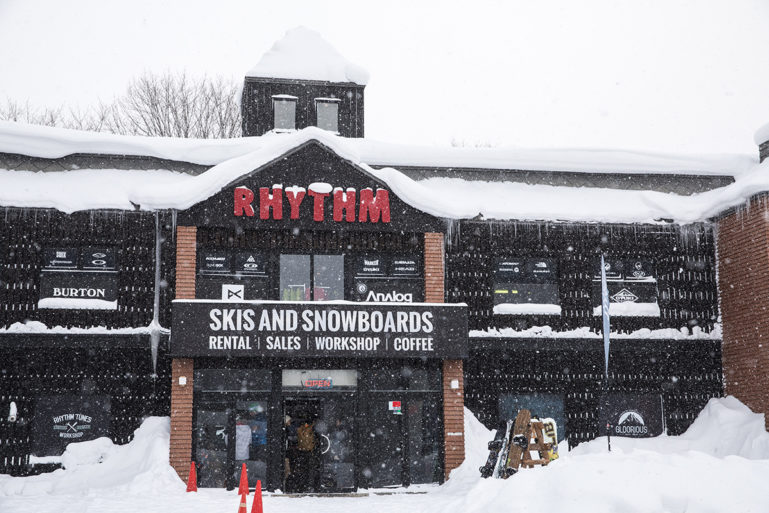
Ski/Snowboard Trip Essential Considerations
The Niseko area has all of the typical services and shops you would expect in a ski town, with the bulk of the businesses based around the Hirafu area, though each base area offers these services. Below are where you can find the trip essentials to get you on the slopes.
Gear Rentals
Each base area has a rental shop, and there are several off-mountain gear rentals in the Hirafu area, though Rhythm is by far the largest and has an excellent reputation for service. Rhythm offers free pickup and dropoff to hotels in the area, and you can even swap out skis for different models each day if you want to test other skis.
Gear Shops
Hirafu has many gear shops throughout the area, with few shops in the other mountain areas. Rhythm is one of the largest, though there is also a Burton flagship store and a North Face store in Hirafu as well. If you are looking to buy any gear for an extended trip, but are turned off by the high prices of new equipment, check out Borderline in Kutchan, a second-hand ski and snowboard gear shop.
The price of ski and snowboard gear and apparel is relatively high in Niseko. However, you can buy ahead in your home country or online and bring an old pair of goggles and gloves as backups if you have them to avoid an expensive emergency purchase.
Lessons
Each base area has a ski school, and there are also some independent lessons available in the Niseko area. Ski schools generally offer the best value through group lessons, giving students more time with casual instruction and practice for the money. Note that the prices are not the same across the different snow schools. Also be aware that private lessons can be much pricier compared to group lessons, one of the best Niseko Travel Guide tips is to go for group lessons as you will get the same instruction for a fraction of the cost.
Hirafu: Go Snow is the international ski and snowboard school in Hirafu, while Niseko Grand Hirafu Ski School is the Japanese language school in Hirafu.
Hanazono: Niseko International Snowsports School is Hanazono’s ski school and offers lessons in English.
Niseko Village: Niseko Village Snow School is an international snow school that offers English language lessons.
Annupuri: Niseko Annupuri Ski and Snowboard School is the Annupuri school, which also offers English language lessons.
Lift Tickets
Lift tickets are sold at all base areas and are offered for an all-mountain pass for all of the Niseko resort areas or a single-area ticket. The Niseko United all-mountain pass prices are listed online here, and the specific area tickets are discounted and more affordable.
Budget Considerations for a Niseko Trip
For those planning a trip budget, below is a consolidated list of the prices mentioned throughout this post. Additionally, other costs for common items may be purchased as part of a winter trip to Niseko. The costs listed below are for the 2025-2026 ski/snowboard season.
Accommodation Costs
High-end Accommodations: ¥50,000 and up per night
Mid-range Accommodations: ¥20,000 to ¥50,000 per night
Budget-friendly Accommodations: ¥5,000 ¥20,000 per night
Dining Costs
High-end Restaurants: ¥10,000 and up per person
Mid-range Restaurants: ¥2,000 to ¥10,000 per person
Budget-friendly Restaurants: ¥2,000 and under per person
Transportation Between Niseko and Sapporo or New Chitose Airport
Bus ¥3,000 to ¥4,500 for Adults one-way
Train ¥3,000 one-way
Private Transfer ¥34,000 and up one-way
Transportation Around Niseko
Hotel Shuttles are Free
The Niseko United Shuttle with a Lift Pass for the day is free.
Niseko United Shuttle or Local Bus fares roughly ¥500 to ¥1,000 between resort areas
Taxi between two neighboring resort areas starts from around ¥2,500
Lift Tickets
Below are just a few prices, reference the Niseko United or ski area websites for a full list.
Niseko United All Mountain Pass Adult
One Day ¥8,500
Five Days ¥36,900
One Day ¥6,600
Five Days ¥29,000
One Day ¥6,800
Five Days ¥29,700
One Day ¥5,900
Five Days ¥24,600
Ski or Snowboard Rentals
Including Boots/Snowboard or Boots/Poles/Skis
Adult From ¥4,500
Children From ¥3,000
Lessons
Prices Vary across Snow Schools, below are indicative starting rates
Private From ¥28,000 for 2 Hours
Adult Group From ¥11,000 for 2.5 Hours
Children From ¥11,000 for 3 Hours
Drinks and Snacks
Bottles Drinks ¥150-250
Coffee ¥300-600
Beer at Convenience store ¥250-450
Beer at Bar or Restaurant ¥500-1000
Bottle of Wine Convenience store ¥1000 and up
Glass of Wine at Restaurant ¥600 and up
Sandwich Convenience store ¥250-350
On-Mountain Lunch ¥1000-2000
The Ultimate Niseko Travel Guide’s Money Saving Tips
There is no denying that a ski or snowboard trip to Niseko can be expensive. Even before you are in town, most visitors will incur a high cost for an international flight, making any savings as part of a trip plan a welcome way to manage your budget. Below are some of the best tips found in this Niseko Travel Guide for saving money for your trip to Niseko.
Buy Lift Tickets Only for What You Need
Plenty of lift ticket options are available depending on your skill level and your desire and endurance to ski or snowboard. If you aren’t looking for a tiring day or only need a few trails to entertain you, consider skipping the full-day all mountain pass, sticking to only one resort, or considering a two or four-hour ticket.
Consider Staying Away From Hirafu
Looking for accommodation away from Hirafu will generally find better rates for similar property types. Yes, Hirafu is the more active resort area with places to eat, drink, and shop, though it is all accessible by bus from the other resort areas. However, you can save a decent amount of your trip budget on accommodation just by opting for one of the non-Hirafu resort areas.
Visit in Early December
If you are more of a beginner skier or snowboarder and are interested in Niseko for the frequent snowfall and Japanese culture, your needs can be met with a trip in early December for a lower price on your accommodation and lift tickets.
Look For Packages that Include Lift Tickets
Like most ski resorts worldwide, Niseko property management companies and hotels often offer discounted packages when you buy your lift tickets and accommodation together.
Opt for Group Instead of Private Lessons
Private lessons are priced significantly higher than group lessons, though you will likely be just as well off with a group lesson. While the extra attention may seem optimal, more is needed to justify the price. A small group lesson will give you a similar amount of instruction time, as the bulk of a lesson is you performing the act of skiing or snowboarding, with occasional instruction taking place.
Condo with a Kitchen
A great tip for every vacation, though great for groups or families in Niseko. Consider booking a condo with a kitchen to save on dining costs.
Visit Grocery Stores
Even if you are staying at a hotel, consider visiting a grocery store to stock up on food, drinks, and snacks and even save on paying the premium for the hotel breakfast buffet. Kutchan offers the largest grocery stores, though there are shops in Hirafu.
Convenience Store Dinners
Japanese convenience stores have become one of the essential parts of a visit to Japan for foreign visitors, and they offer a great way to save on a dinner or two during your ski trip. Offering a variety of meal items like fried chicken, sandwiches, onigiri, instant noodles, salads, and plenty of other snacks, a convenience store dinner is an interesting way to save money and experience more of Japanese culture.
Ramen Dinners
Many of Niseko’s restaurants can be pricey for those looking to save during their trip. Another affordable meal option is visiting Hirafu’s ramen shops for more affordable Japanese cuisine.
Try the Food Trucks
Niseko has a surprising number of food trucks based around Hirafu, offering Indian, fish and chips, kebabs, and more. Save on your dinner or lunch with a trip to these trucks.
Splurge on Dining in Sapporo
As a final food tip, if food is one of your key interests during your trip to Niseko, consider adding a night or two in Sapporo at either end of your journey. Sapporo offers a far more extensive number of exciting and great value restaurants for all types of food, especially local seafood, especially sushi. Naturally, Niseko restaurants charge tourist-style prices, especially fine dining restaurants, so that you can get far more bang for your buck in Sapporo. This is a top recommendation from this Niseko Travel Guide.
Packing List Considerations
Packing considerations for a trip to Niseko are similar to any ski or snowboarding trip, with the expectation being for more snow than sun. However, some items below may be unique for a trip to Niseko.
Clear Goggle Lenses: Niseko offers extensive night skiing in Hirafu, one of the best evening experiences in the area. Buy an extra clear goggle lens if you don’t have one, as going night skiing with dark lenses is not the safest way to ski.
Avalanche Beacon & Gear: If you are an expert skier or snowboarder with an avalanche beacon, shovel, probe, etc., bring them on your trip. It’s also an expectation that you would have gone through avalanche safety training before the trip, as it’s not the best decision to first learn these skills on a trip to an unfamiliar mountain.
Non-Slip Waterproof Winter Boots: Bring them if you already have good winter boots for snow and ice. You may also consider investing in a pair if you get enough future use from them on other trips. Niseko’s sidewalks, streets, and pathways are about as snow-covered as you will find in the ski world. While they do a great job in snow maintenance, you are bound to be walking through plenty of snow over your trip, and if there is an odd sunny or rainy day, you will encounter plenty of ice.
Waterproof Snow Apparel: This suggestion seems obvious. However, there are always a surprising number of visitors to Niseko that you can see on the mountain in an oversized frosted hoodie or ones with completely soaked jackets at the end of a snowy day. So expect constant snow and dress for it.
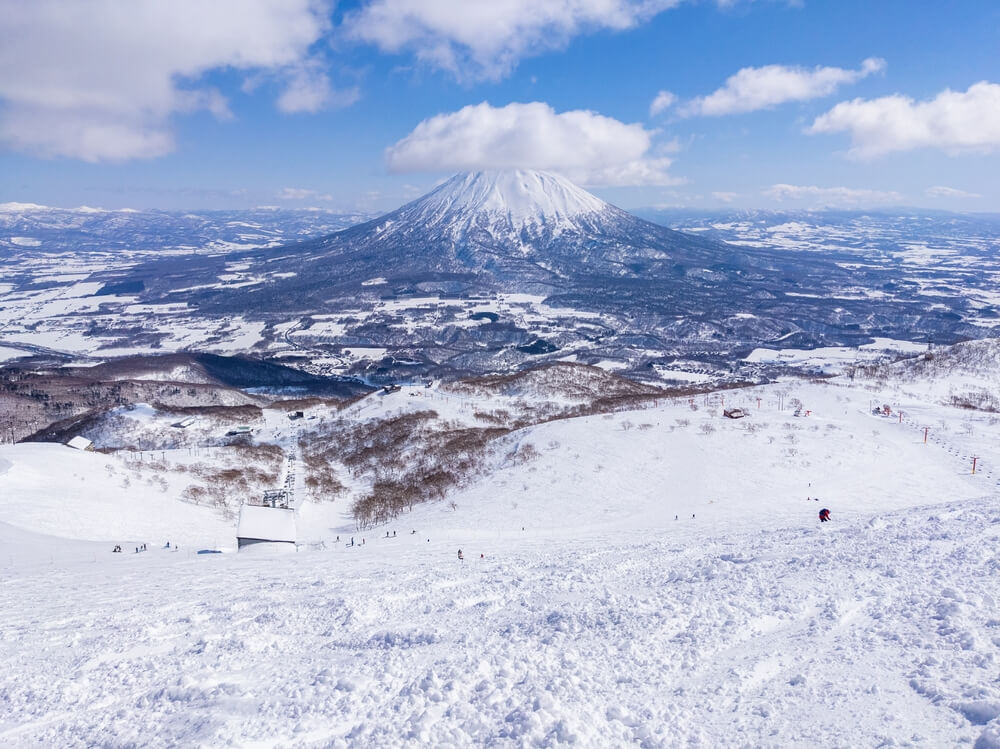
Niseko and Japan Trip Essentials
To cover some typical trip considerations when visiting Japan and Niseko, below are some essentials for planning a trip to the region.
Japanese Language
Niseko is the most non-Japanese place in all of Japan regarding language. There are more English speakers per capita in Niseko than anywhere else in the country. Signage is often in Japanese and English, and most staff speak English at restaurants, hotels, and shops.
Yes, there will be exceptions to this, though there is rarely anything so tricky that the staff member won’t be able to find someone else to help, and if you have Google Translate on your phone, you’ll always have a backup. Avoid being the obnoxious foreign tourist who keeps repeating the same thing in a louder and firmer tone when you aren’t understood the first time; use an app if you are stuck.
While traveling to Sapporo or nearby side trips from Niseko, you are more likely to interact with Japanese speakers who can’t speak English. However, there is a strong tourism culture in Hokkaido, which means language should rarely be a problem unless you go off the beaten track. So again, have Google Translate on your phone, and you will be ok.
Currency and Credit Cards
Foreign credit cards are accepted nearly everywhere, and if you don’t have a foreign transaction fee, this should be your first choice for payment. Visa, Mastercard, and Amex will give you the best exchange rate.
There are foreign card ATMs in Hirafu, major hotels, and New Chitose Airport. These are your best bet for exchange rates and to be aware of foreign exchange considerations while traveling abroad and in Japan, read our post on 19 Tips for Exchanging Currency While Traveling.
Wifi and Connectivity
Hotels will all offer free Wifi, mountain lodges, and Niseko United buses will as well. Many restaurants will offer it to customers as well. If you prefer to stay connected throughout your trip, consider picking up a SIM card or mobile Wifi device at New Chitose Airport when you arrive.
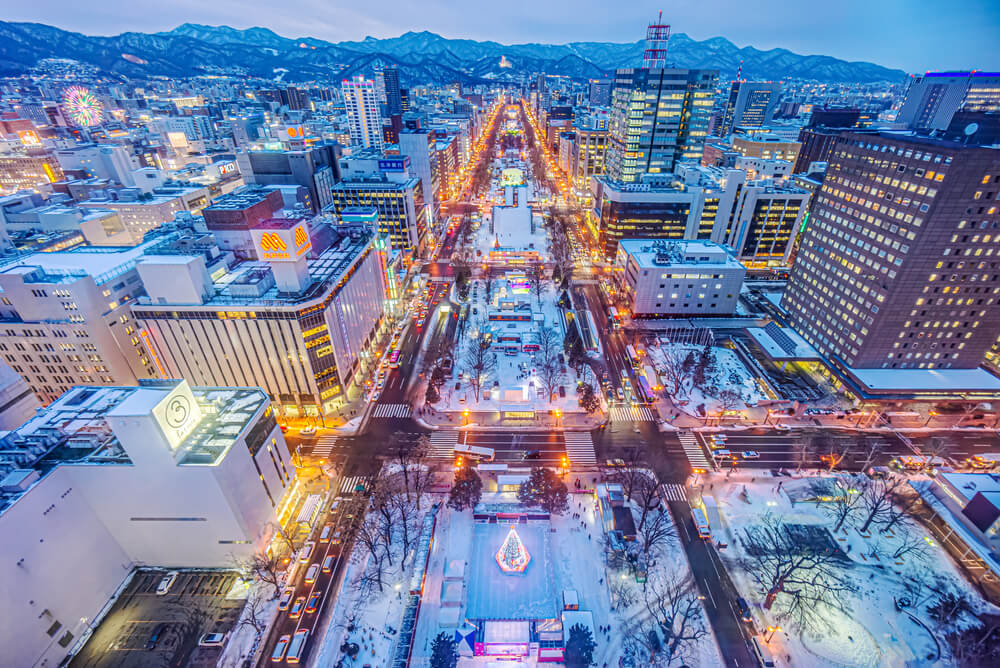
Niseko Travel Guide: Side Trips from Niseko
If you are spending a week or two skiing and riding at Niseko and need an off-day to rest, want to try out another nearby ski resort, or want to explore more of the area, below are your best options for side trips in Southwestern Hokkaido.
Sapporo
The best complementary destination to Niseko as part of a ski or snowboard trip in Japan, Sapporo offers a incredible dining options, a handful of local attractions, and a unique nightlife scene. There are larger stores for shopping around Sapporo Station, extremely budget-friendly hotels, a beer factory, a chocolate factory, a seafood market, and enough ramen shops than you could ask for.
While it is possible to make a day trip to Sapporo by train from Kutchan Station, it’s easier to add it before or after Niseko, or if you are a food-focused traveler, stop by going both to and from Niseko.
Otaru
The seaside city of Otaru is accessible by a 90-minute train ride from Kutchan Station. The city is walkable from the station and is known for being one of the oldest port cities in Hokkaido. Famous for its late 19th-century buildings, robust art community, and fresh seafood restaurants, with many ingredients starting their day on boats in the harbor. Considering the travel time, Otaru is suitable for a day trip. Plan to spend a few hours in the city, including a meal.
Rusutu
The closest large ski resort to Niseko, Rusutsu receives the same impressive snowfall totals as Niseko, though it has an entirely different feel. It offers more cruiser runs, no above treeline skiing, though amazing tree skiing. Niseko ground services offer a one-day lift ticket and round-trip bus package from their website.
Kiroro
Southwestern Hokkaido’s other large ski area sits further away than Rusutsu, and does not have the same bus connections. Kiroro is another fantastic powder paradise. While it’s only an hour from Niseko by car, it receives different weather patterns, so it can have a powder day while Niseko has no snowfall. For those with a vehicle, consider a day trip to Kiroro to sample another Hokkaido ski gem.
Niseko Travel Guide: Resources for Reference
Below are links to other useful resources that have been mentioned above and can be used as part of your Niseko trip planning.
Snow Japan Daily Niseko Snow Report
Snow Forecast Niseko Weather Report
To Conclude the Niseko Travel Guide
Hopefully, the above Niseko travel guide helped with your trip planning and research for your trip to Niseko. This guide will be periodically updated to reflect Niseko’s changes, openings, and developments. Best of luck with planning your trip to Niseko!
